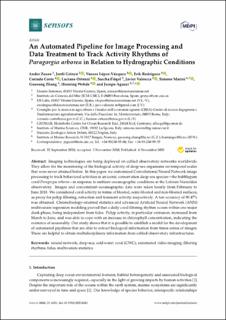An Automated Pipeline for Image Processing and Data Treatment to Track Activity Rhythms of Paragorgia arborea in Relation to Hydrographic Conditions
| dc.contributor.author | Zuazo, Ander | |
| dc.contributor.author | Grinyo, Jordi | |
| dc.contributor.author | López-vázquez, Vanesa | |
| dc.contributor.author | Rodriguez, Erik | |
| dc.contributor.author | Costa, Corrado | |
| dc.contributor.author | Ortenzi, Luciano | |
| dc.contributor.author | Flögel, Sascha | |
| dc.contributor.author | Valencia, Javier | |
| dc.contributor.author | Marini, Simone | |
| dc.contributor.author | Zhang, Guosong | |
| dc.contributor.author | Wehde, Henning | |
| dc.contributor.author | Aguzzi, Jocopo | |
| dc.date.accessioned | 2021-04-26T11:28:37Z | |
| dc.date.available | 2021-04-26T11:28:37Z | |
| dc.date.created | 2021-03-25T14:06:07Z | |
| dc.date.issued | 2020 | |
| dc.identifier.citation | Sensors. 2020, 20 . | en_US |
| dc.identifier.issn | 1424-8220 | |
| dc.identifier.uri | https://hdl.handle.net/11250/2739567 | |
| dc.description.abstract | Imaging technologies are being deployed on cabled observatory networks worldwide. They allow for the monitoring of the biological activity of deep-sea organisms on temporal scales that were never attained before. In this paper, we customized Convolutional Neural Network image processing to track behavioral activities in an iconic conservation deep-sea species—the bubblegum coral Paragorgia arborea—in response to ambient oceanographic conditions at the Lofoten-Vesterålen observatory. Images and concomitant oceanographic data were taken hourly from February to June 2018. We considered coral activity in terms of bloated, semi-bloated and non-bloated surfaces, as proxy for polyp filtering, retraction and transient activity, respectively. A test accuracy of 90.47% was obtained. Chronobiology-oriented statistics and advanced Artificial Neural Network (ANN) multivariate regression modeling proved that a daily coral filtering rhythm occurs within one major dusk phase, being independent from tides. Polyp activity, in particular extrusion, increased from March to June, and was able to cope with an increase in chlorophyll concentration, indicating the existence of seasonality. Our study shows that it is possible to establish a model for the development of automated pipelines that are able to extract biological information from times series of images. These are helpful to obtain multidisciplinary information from cabled observatory infrastructures. | en_US |
| dc.language.iso | eng | en_US |
| dc.title | An Automated Pipeline for Image Processing and Data Treatment to Track Activity Rhythms of Paragorgia arborea in Relation to Hydrographic Conditions | en_US |
| dc.type | Peer reviewed | en_US |
| dc.type | Journal article | en_US |
| dc.description.version | publishedVersion | en_US |
| dc.source.pagenumber | 23 | en_US |
| dc.source.volume | 20 | en_US |
| dc.source.journal | Sensors | en_US |
| dc.identifier.doi | 10.3390/s20216281 | |
| dc.identifier.cristin | 1901060 | |
| cristin.ispublished | true | |
| cristin.fulltext | original | |
| cristin.qualitycode | 1 |
Tilhørende fil(er)
Denne innførselen finnes i følgende samling(er)
-
Articles [3001]
-
Publikasjoner fra CRIStin [3025]
